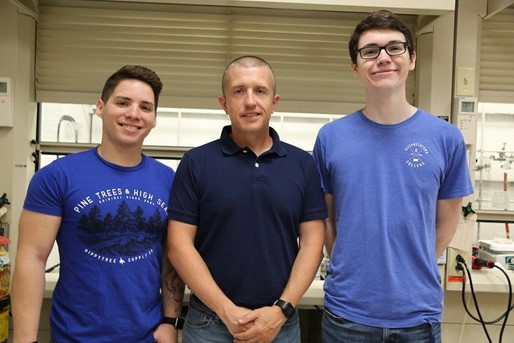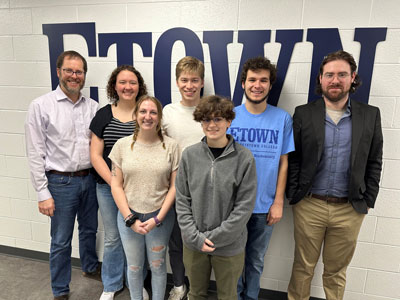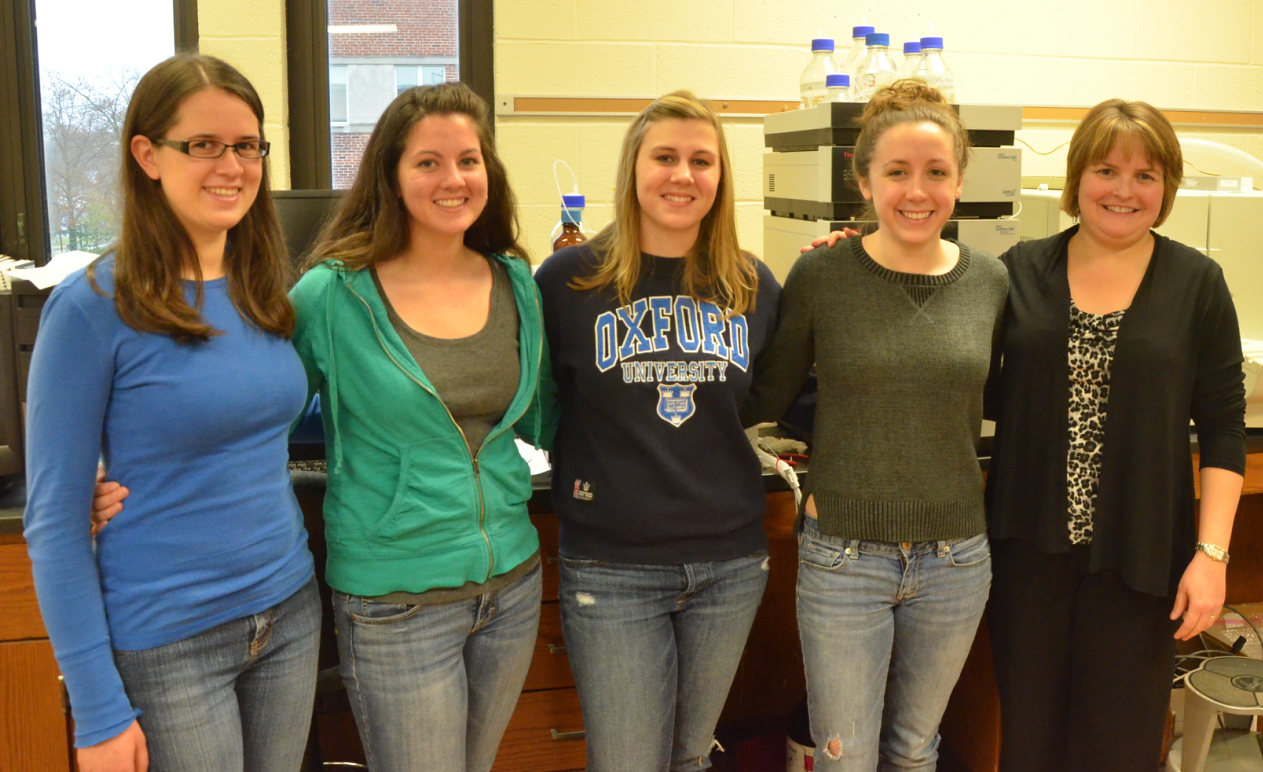Faculty and Student Research
Many students will present the results of their research at national, regional, and local meetings. Especially for the national meetings, proposals for research presentation must be submitted and the approved for inclusion in the meeting.
Fast Facts:
27
Undergraduate Coauthors
Departmental faculty members have published 21 peer-reviewed articles with a total of 27 undergraduate coauthors since 2008.
>1/3
Students Engaged in Research
Greater than 1/3 of all departmental majors are actively engaged in research during each academic year.
7
Students in Summer Research
An average of 7 students per summer participate with a faculty mentor in our Summer Research Program through which they receive a research stipend, room, and board.
Undergraduate research is both the cornerstone and the capstone of the Elizabethtown College Chemistry & Biochemistry curriculum. Students can begin independent research with a faculty mentor as early as their first year and work with one or more faculty mentors during the academic year and summer, leading up to completion of a required research experience during the senior year. In addition, fundamental research questions are routinely incorporated into the teaching laboratories associated with specific courses.
To learn more about the ongoing work of faculty and student researchers in the Department of Chemistry and Biochemistry at Elizabethtown College, please see the brief descriptions provided here for each group, or contact us. We love to talk about our research, and so do our students!
Learn more about the Chemical Hygiene Plan
Learn more about the Emergency Spill Response Procedure
Dr. Jeffrey Rood's Research Group

Research interests lie in two main areas. In coordination chemistry, new alkaline earth and transition metal complexes are synthesized, characterized, and evaluated as potential catalysts for various types of reactions or applied to cellular systems as possible insulin mimetics. Also under development are novel Metal-Organic Frameworks, porous materials composed of metal ions and organic linker molecules that assemble together into extended, three-dimensional structures, and whose pore shape and size are dictated by the identity of the metal and the length of the organic molecules. These materials are of interest for applications such as the storage of small molecules and potential as luminescence-based sensors.
Representative Publications (Etown undergraduate student authors underlined):
- Rood, J. A.; Subedi, C. B.; Risell, J. P.; Astashkin, A. V.; Rajaseelan, E. [(1,2,5,6-η)-Cycloocta-1,5-diene](1-ethyl-3-isopropyl-1,3-imidazol-2-ylidene)(triphenylphosphane)rhodium(I) tetrafluoridoborate. IUCrData 2021, 6, x210597.
- Rood, J. A.; Reehl, S. R.; Jacoby, K. A.; Oliver, A. G. Crystal structures of a series of bis(acetylacetonato)oxovanadium(IV) complexes containing N-donor pyridyl ligands. Acta Cryst. 2020, E76, 826-830.
- Rood, J. A.; Landis, A. M.; Forster, D. R.; Goldkamp, T.; Oliver, A. G. Solvent dependence of the solid-state structure of salicylaldiminate magnesium amide complexes. Acta Cryst. 2016, C72, 990-996.
- Wagner, A. M.; Strohecker, S. A.; Costello, E. K.; Rood, J. A.; Kneas, K. A. Water-soluble osmium complexes suitable for use in luminescence-based, hydrogel-supported sensors. J. Fluoresc. 2016, 26, 2271-2280.
Dr. James MacKay's Research Group

Synthetic organic chemistry is used to construct interesting and relevant target molecules. Much of our work involves heterocyclic chemistry focused on the synthesis of molecules capable of sensing and molecular recognition. Current efforts focus on the design of novel peptide nucleic acid (PNA) monomers that are capable to binding sequence selectively with double stranded RNA. These PNAs will be used in biotechnological applications aimed at understanding more about non-coding RNA. Other projects include synthesis rhodamine derivatives that could be used in mercury sensing applications, a green method for functionalization of pyrazoles, and use of microwaves to accelerate organic transformations.
Representative Publications (undergraduate student authors underlined):
- “Triplex-forming peptide nucleic acids as emerging ligands to modulate structure and function of complex folded RNAs” Katkevics, M.; MacKay, J. A.; Rozners, E. Chem. Commun, 2024, 60, 1999-2008 (Feature Article - DOI: 10.1039/D3CC05409H)
- “Synthesis of 2-Aminopyridine-Modified Peptide Nucleic Acids” Kumpina, I.; Baskevics, V.; Walby, G.; Tessier, B.R.; Saei, S.F.; Ryan, C.A; MacKay, J.A.; Katkevics, M.; Rozners, E. Synlett 2024, 35, 649-653. (DOI: 10.1055/a-2191-5774)
- “Improved Triplex-Forming Isoorotamide PNA Nucleobases for A-U Recognition of RNA Duplexes” Talbott, J. M.; Tessier, B.R.; Harding, E.E.; Walby, G.D.; Hess, K.D.; Baskevics, V.; Katkevics, M.; Rozners, E.; MacKay, J.A. Chem. Eur. J. 2023, e202302390. (Hot Paper) (DOI: 10.1002/chem202302390)
- “Extended Peptide Nucleic Acid Nucleobases Based on Isoorotic Acid for the Recognition of A–U Base Pairs in Double-Stranded RNA” Brodyagin, N.; Maryniak, A. L.; Kumpina, I.; Talbott, J. M.; Katkevics, M.; Rozners, E.; MacKay, J. A. Chem. Eur. J. 2021, 27, 4332-4335. (Hot Topic) (DOI: 10.1002/chem.202005401)
- Synthesis and RNA binding properties of extended nucleobases for triplex-forming peptide nucleic acids” Kumpina, I.; Brodyagin, N.; MacKay, J. A.; Kennedy, S. D.; Katkevics, M. Rozners, E. J. Org. Chem., 2019, 84, 13276-13298 . (DOI: 10.1021/acs.joc.9b01133)
- Olsen, K.L.; Jensen, M. R.; MacKay, J. A. A mild halogenation of pyrazoles using sodium halide salts and Oxone. Tetrahedron Lett. 2017, 58, 4111-4114. (DOI: 10.1016/j.tetlet.2017.09.042)
Dr. Lauren Toote's Research Group

Our broad research goal is to develop diagnostic tools for environmental and medical applications. Currently, we are designing a water quality test that is sensitive, simple and inexpensive. Projects include the synthesis of colorimetric molecular probes for heavy metals, encapsulation of these probes into polymer nanoparticles and the incorporation of these nanoparticles into a lateral flow assay. The culmination of this project will be a paper-based test for the detection of mercury and lead in drinking water samples. Additionally, we are working to develop a fast and specific, magnetic-bead immunoassay for Lyme Disease. These projects give students experience in synthetic, materials, bio and analytical chemistry.
Representative Publications:
- Hughes, Steven M.; Hendricks, Mark P.; Mullaugh, Katherine M.; Anderson, Mary E.; Bentley, Anne K.; Clar, Justin, G.; Daly Jr, Clyde A.; Ellison, Mark D.; Feng, Z. Vivian; …Toote, Lauren E.; et al. The Primarily Undergraduate Nanomaterials Cooperative: A new model for supporting collaborative research at small institutions on a national scale. ACS Nanosci. Au 2021, 1(1), 6-14. (DOI:10.1021/acsnanoscienceau.1c00020)
- Tzepos, Robert G.; Raman, Easwer; Toote, Lauren E.; Wright, David W.; Gerdon, Aren E. Signal Amplification with Co(III) Protoporphyrin IX Nanoparticles and Anodic Stripping Voltammetry. Electroanal 2021, 33, 1-8. (DOI: 10.1002/elan.202100108)
- Markwalter, Christine F.; Gibson, Lauren E.; Mudenda, Lwiindi; Kimmel, Danielle W.; Mbambara, Saidon; Thuma, Philip E.; Wright, David W. Characterization of Plasmodium Lactate Dehydrogenase and Histidine-Rich Protein 2 Clearance Patterns via Rapid On-Bead Detection from a Single Dried Blood Spot. Am J Trop Med Hyg 2018, 98 (5), 1389-1396. (DOI: 10.4269/ajtmh.17-0996)
- Gibson, L.E.; Markwalter, Christine F.; Kimmel, Danielle W.; Mudenda, Lwiindi; Mbambara, Saidon; Thuma, Philip E.; Wright, David W. Plasmodium falciparum HRP2 ELISA for Analysis of Dried Blood Spot Samples in Rural Zambia. Malar. J. 2017 16:350. (DOI: 10.1186/s12936-017-1996-4)
- Gibson, L. E.; Wright, David W. Sensitive Method for Biomolecule Detection Utilizing Signal Amplification with Porphyrin Nanoparticles Anal. Chem. 2016, 88(11), 5928-5933. (DOI: 10.1021/acs.analchem.6b00855)
Dr. Kristi Kneas's Research Group

Specific research projects in analytical chemistry are designed to further efforts in one of three broad areas of interest: luminescence-based sensing materials and schemes to measure clinically and environmentally-relevant targets (e.g., oxygen, humidity, and blood lactate levels), improved instrumentation and industrial processes (e.g. laser spectroscopy, polyelectrolyte membrane fuel cells, greener manufacturing processes), and analytical sensing schemes for forensics applications (e.g., authentication of questioned documents using Ion pairing-HPLC for ink dating).
Representative Publications (undergraduate student authors underlined):
- Wagner, A. M.; Strohecker, S. A.; Costello, E. K.; Rood, J. A.; Kneas, K. A. Water-soluble osmium complexes suitable for use in luminescence-based, hydrogel-supported sensors. J. Fluoresc. 2016, 26, 2271-2280. (DOI: 10.1007/s10895-016-1923-z)
- Strohecker, S.('12); Kneas, K.; Obetz, D.; Ochoa-Putman, C. Study of Urethane Prepolymer Stability Using Fourier-Transform Infrared Spectroscopy. Technical Report; Polyurethane Manufacturers Association; April 24, 2012.
- Tellis, J.C.('12); Strulson, C.A.('09); Myers, M.M.('11); Kneas, K.A. Relative Humidity Sensors Based on an Environment-Sensitive Fluorophore in Hydrogel Films. Anal. Chem. 2011, 83(3), 928-932.
- Kneas, K.A.; Fontinell, M.; Armstrong, D.L.; Brank, A.R.; Johnson, A.L.; Kissinger, C.A.; Mabe, A.R. Greening up Auto Part Manufacturing: A Collaboration between Academia and Industry. J. Chem. Educ. 2009, 86, 212-215.

